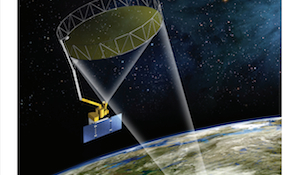Science Cheerleader, NASA, SciStarter enlist youth cheerleaders and football players as citizen scientists for nationwide research that examines soil moisture conditions and water availability
Grant from Youth Learning as Citizen Environmental Scientists enables Science Cheerleaders and SciStarter to recruit, train, and equip youth in STEM research

NASA’s new Soil Moisture Active Passive (SMAP) satellite
Philadelphia, PA – (July 25, 2015) – NASA scientists are on a mission to map global soil moisture, and through SciStarter and Science Cheerleader, they’re teaming up with citizen scientists to gather valuable data from the ground to complement and validate what is seen from space.
Known as the Soil Moisture Active Passive (SMAP) satellite mission, the research will help scientists understand links among Earth’s water, energy and carbon cycles; reduce uncertainties in predicting climate; and enhance the ability to monitor and predict natural hazards like floods and droughts. SMAP data have additional practical applications for citizens everywhere, including improved weather forecasting and crop yield predictions.

A Science Cheerleader leads Pop Warner cheerleaders on study of microbes on Earth and on the Space Station.
Following on the success of Project MERCCURI, a 2013-2014 citizen science partnership between Pop Warner Youth Scholars, Inc., UC Davis/Eisen Lab, SciStarter, and Science Cheerleader, involving microbial research on the International Space Station, Youth Learning as Citizen Environmental Scientists (YLACES.org) has announced a $50,000 grant to SciStarter , in partnership with Science Cheerleader, to recruit, train, and equip teams in all 50 states to measure and report soil moisture measurements at regular intervals. Data will be made available to local decision-makers and it will be used to help validate and calibrate NASA’s SMAP satellite.
On mornings when SMAP is scheduled to fly over a team’s site or before or after a game or practice, the football and cheer teams will take soil samples from the top 5 cm (2 inches) of soil, weigh it, dry it under a heat lamp, and weigh again. The decrease in weight is equal to the mass of water that was in the sample – its soil moisture. Measurements are simple to take and appropriate for all citizen scientists, including youth. Each participating team will provide several measurements per month during football season. Several teams are forming “SMAP clubs” to provide clusters of 10 measurements covering an area 10 km in radius and report data more frequently.
“Participating in this project will enable anyone, anywhere, to learn more about the quality of their soil (including football fields!) , compare that to others at local, regional, national and global scales, and see the application of their work applied to an important, large-scale research effort at NASA,” said Darlene Cavalier, founder of Science Cheerleader and SciStarter. “With this YLACES grant, we’re able to help connect people to the tools and resources needed to engage meaningfully in participatory STEM research. “
This grant also makes it possible for one team from each state to receive tools needed for this project including a heat lamp, graduated cylinders, data sheets and a companion rain gauge for a complementary citizen science project measuring rain, snow and hail precipitation. This kit is valued at more than $250. Kits will also be made available for purchase via SciStarter and at a new lending library coordinated by SciStarter and MyTurn.com.
Brian Campbell, a member of the SMAP team at NASA, emphasized the importance of the measurements that will be taken on the ground. “Having citizen scientists collect data is vital to the SMAP Mission. Their data can be compared to the SMAP satellite data and used as a source of validation. This validation will allow for a much more robust and accurate dataset, giving an optimal understanding of global soil moisture.”
How to Participate in the SMAP Project
EVERYONE is invited to participate! Science enthusiasts, people who are concerned about their environment and our global water resources, teachers, athletes, families, civic groups, gardeners – anyone who will commit to taking regular soil measurements – can become part of this important research. Indicate interest by completing a brief online form BY AUGUST 10.
Pop Warner participants can include their involvement for credit on their Pop Warner Scholarship Application!
Teachers of students from grades 3-12 are encouraged to visit SciStarter.com/SMAP for ideas and tools for incorporating this SMAP project into their lesson plans.
Importance of Citizen Science to Society and Students
Science is our most reliable system of gaining new knowledge and citizen science is the public involvement in inquiry and discovery of new scientific knowledge. A citizen science project can involve one person or millions of people collaborating towards a common goal. A recent report from the National Academies[1] confirmed that opportunities to learn STEM outside of school directly affect what is possible inside classrooms. The report showed that out-of-school programs (such as this SMAP citizen science program) can contribute to young people’s interest in and understanding of STEM, connect young people to caring adults who serve as role models, and can even reduce the achievement gap between young people from low-income and high-income families.
“With this YLACES grant and the NASA soil project, we’re engaging youth in meaningful research about their environment, their future. They can see the importance of the research, they feel important because they’re part of it, and they can learn about how to affect change for the future. What a fantastic opportunity for both the students and the scientists,” concluded Cavalier.
About SciStarter
SciStarter aims to enable people to contribute to science through informal recreational activities and formal research efforts. The web site creates a shared space where scientists can connect with citizens interested in working on or learning about joint research projects. SciStarter currently features 1,000 searchable citizen science projects and recruits participants through partnerships with Discover Magazine, the National Science Teachers Association, Public Library of Science, WHYY/NPR, Pop Warner Youth Scholars, and more.
###
[1] Identifying and Supporting Productive STEM Programs in Out-of-School Settings ( 2015 )

